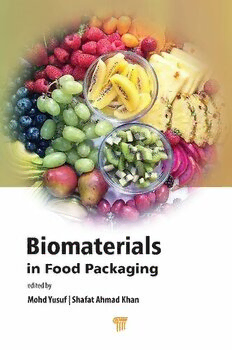Table Of ContentBiomaterials
in Food Packaging
Biomaterials
in Food Packaging
edited by
Mohd Yusuf
Shafat Ahmad Khan
Published by
Jenny Stanford Publishing Pte. Ltd.
101 Thomson Road
#06-01, United Square
Singapore 307591
Email: [email protected]
Web: www.jennystanford.com
British Library Cataloguing‑in‑Publication Data
A catalogue record for this book is available from the British Library.
Biomaterials in Food Packaging
Copyright © 2022 Jenny Stanford Publishing Pte. Ltd.
All rights reserved. This book, or parts thereof, may not be reproduced
in any form or by any means, electronic or mechanical, including
photocopying, recording or any information storage and retrieval
system now known or to be invented, without written permission from
the publisher.
For photocopying of material in this volume, please pay a copying fee
through the Copyright Clearance Center, Inc., 222 Rosewood Drive,
Danvers, MA 01923, USA. In this case permission to photocopy is not
required from the publisher.
ISBN 978-981-4877-98-5 (Hardcover)
ISBN 978-1-003-25678-6 (eBook)
Contents
Preface xiii
1. Biomaterials for Food Packaging:
An Overview 1
Fazilah Ariffin, Hanisah Kamilah, Kaiser Mahmood,
and Alias A. Karim
1.1 Introduction 2
1.2 Categories of Biomaterials 3
1.3 Advantages and Disadvantages of Biomaterials 8
1.4 Degradation of Biomaterials 9
1.5 Biomaterials vs. Synthetic Plastics for
Food Packaging 12
1.6 Methods of Forming
Biomaterial-Based Packaging 17
1.6.1 Film Preparation Methods 17
1.6.2 Advancements in Packaging Material
Development 21
1.7 Safety Concerns of
Biomaterial-Based Packaging 29
1.8 Global Trends toward Biodegradable
Polymers Packaging 33
2. A1.c9t ive ICnogrnecdluiesniotsn Enabled Edible Coatings and
35
Films Improve Shelf Life of Food: An Overview 49
Tanvir Arfin
2.1 Introduction 50
2.2 Background 51
2.3 Functions and Advantages 52
2.4 Importance of EC and EF 53
2.5 Structural Matrix 53
2.6 Synthesis of EF 55
vi Contents
2.7 Barrier Feature 55
2.8 Active Biopackaging 55
2.9 Chemistry of EF and EC 57
2.9.1 Polysaccharide 58
2.9.2 Protein 65
2.9.3 Composite 68
2.10 Economic and Nutritional Influences 69
2.11 Protection of Food Product:
Mechanism Phenomena 70
2.12 Healthy Foods: Public Demands 70
3. S2u.1r3fa ceC Cohnecmluisstioryn for Intelligent Food Packaging 7803
S ivapriya Veeraiyan, Abdul Azeez Nazeer,
Saravanan Dhandapani, and
Sudarshana Deepa Vijaykumar
3.1 Introduction 84
3.2 Simple Food Package and Intelligent Devices 85
3.3 Intelligent Packaging Technique 86
3.4 Devices Used in IPT 86
3.5 Indicators of IPT 87
3.5.1 Temperature Indicators 87
3.5.2 Gas Indicators 89
3.5.3 Freshness Indicators 90
3.5.4 Sensors 92
3.5.5 Data Carriers 97
3.6 Other IPT Systems 99
4. B3 .r7ie f OvSeurmvimewa royf aAnsdp iFriuntgu Prero Ppreorstpieesc otsf oFfu InPcTti onal
99
Biopolymers for Food Packaging Applications 105
Pooja Agarwal, Anjali Gupta, and Divya Tripathy
4.1 Introduction 106
4.2 Biopolymer 107
4.2.1 Polysaccharide-Based Biopolymer 108
4.2.2 Synthetic Biopolymer 109
Contents vii
4.3 Desirable Properties of Biopolymers for
Food Packaging Application 111
4.3.1 Gas Barrier 111
4.3.2 Thermal and Mechanical 112
4.3.3 Moisture Barrier 113
4.3.4 Biodegradability 114
4.4 Functional/Active Packaging 114
5. R4 e.5c ent CRoensecalurcshio ann d Development in
116
Food Packaging Technologies: A Review 121
S yed Dilshad Alam, Rupak Raja, Vikas Shirsath,
Arvind Kumar Jain, Shafat Ahmad Khan, and
Imran Ali
5.1 Introduction 122
5.2 K ey Functions and Requirements of
Food Packaging 122
5.3 Packaging Technologies Prospects 123
5.3.1 Conventional Technology 124
5.3.2 Modern Technology 124
6. E5 d.4ib le CCooantcinlugss:i oRne caenndt FAudtvuarnec Demimeenntss ioonn
131
Protein- and Polysaccharide-Based Films 137
A njali Gupta, Divya Tripathy,
Meenu Aggarwal, and Pooja Agarwal
6.1 Introduction 138
6.2 Protein-Based Edible Films and Coatings 139
6.2.1 Globular Proteins 140
6.2.2 Fibrillar Proteins 143
6.3 P olysaccharide-Based Edible
Films and Coatings 144
6.3.1 Starch-Based Coatings and Films 145
6.3.2 Cellulose-Based Coatings and Films 147
6.3.3 Chitosan-Based Coatings and Films 147
6.3.4 Pectin-Based Coatings and Films 148
6.3.5 Alginate-Based Coatings and Films 149
6.4 Conclusion 150
viii Contents
7. Characterization of Cassava Starch-Zinc
Nanocomposite Film for Food Packaging 159
Adeshina Fadeyibi
7.1 Introduction 160
7.2 Materials and Methods 162
7.2.1 S ynthesis and Particle Size Analysis of
Nanoparticles 162
7.2.2 Development of Nanocomposite Film 162
7.2.3 D etermination of Structural and
Barrier Properties 163
7.2.4 D etermination of Thermal and
Rheological Properties 165
7.3 Results and Discussion 166
7.3.1 Permeability of Nanocomposite Film 166
7.3.2 Thermal Stability of
Nanocomposite Film 169
7.3.3 Mechanical Properties of
Nanocomposite Film 170
7.3.4 Structural Stability of
Nanocomposite Film 173
8. R7 e.4v iewC oonn Aclduvsaionnce d Food Packaging Materials
176
Based on Functional Biopolymer Matrix 181
M d. Aftab Alam, Rizwana Khatoon, Shamsul Huda,
and Pramod Kumar Sharma
8.1 Introduction 182
8.2 Origin and Description of Bio-Based Polymers 184
8.3 Polysaccharides 184
8.3.1 Plant-Based Polysaccharides 185
8.3.2 Animal-Based Polysaccharides 187
8.4 Proteins 191
8.4.1 Plant-Based Proteins 191
8.4.2 Animal-Based Proteins 193
8.4.3 Microbial-Based Proteins 195
Contents ix
8.5 Edible Films and Coatings 196
8.6 Properties of Edible Films 197
8.6.1 Antimicrobial Activity 197
8.6.2 Antioxidant Activity 197
8.7 Alginate-Based Edible Films 198
8.8 Protein-Based Edible Films 198
8.9 Fossil-Based Biopolymeric Blends 199
8.10 Future Perspective 199
9. P 8r.1o1sp ecCtos nocfl Nusainoonm aterials in Active Finishing
200
of Food and Food Packaging: A Review 219
D ivya Bajpai Tripathy, Anjali Gupta,
and Pooja Agarwal
9.1 Introduction 220
9.2 F ood Packaging Applications of Nanomaterials 221
9.2.1 Protective Finishing of Food 222
9.2.2 Enhancement of Barrier Properties 222
9.2.3 Active Packaging 222
9.2.4 Intelligent or Smart Packaging 223
9.2.5 Surface Biocides 224
9.2.6 Antioxidant Properties 224
9.2.7 D etection of Spoilage and Pathogenic
Microorganisms 225
9.2.8 Humidity Indicators 226
9.2.9 Bio-Based Food Packaging 227
9.3 N anotechnology: Environmental and
Human Safety Prospects 227
10. A9 .p4p licaCtioonncsl oufs iNoann o-Biocomposite Materials
227
as Antimicrobial and Antioxidant Finishing
Agents for Packaged Food Products 233
Md. Aftab Alam, Rizwana Khatoon, Shamsul Huda,
Niyaz Ahmad, and Pramod Kumar Sharma

